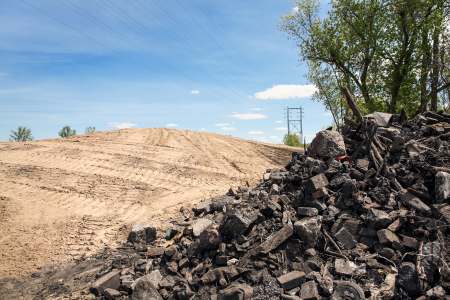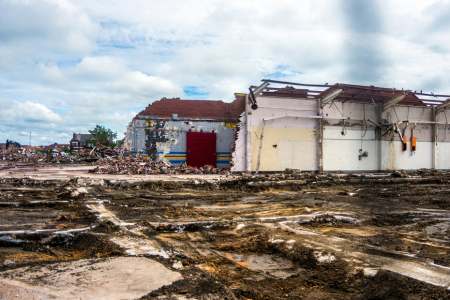The Environmental Protection Agency (EPA) currently estimates over 450,000 brownfield lands across the United States. These sites represent undeveloped land underutilized due to the presence or potential of environmental contamination. Brownfield redevelopment is a process that seeks to change that.
What is brownfield redevelopment? Brownfield redevelopment programs aim to restore previously unusable land, providing valuable assets for communities and businesses alike.
This article explores how redevelopment programs are reshaping the American landscape. Here’s how brownfield redevelopment is revitalizing and renewing communities across the U.S.
Table of Contents
What Is Brownfield Redevelopment?
While brownfield status is a legal designation, the exact definition of a brownfield varies between agencies.
In the U.S., the EPA defines a brownfield as any land impacted by “the presence or potential presence of a hazardous substance, pollutant, or contaminant.” However, the term is sometimes more generally applied to land affected by pollution and needs to be upgraded.
What is brownfield redevelopment? It is the process of reusing or redeveloping land previously abandoned, unused, or underutilized due to contamination of the environment, which may have occurred from the following property uses:
- Factories
- Warehouses
- Service stations
- Dry cleaners
- Parking lots and garages
- Airstrips and aircraft hangars
- Landfills
- Bus terminals
The designation originated in 1992 when the Northeast-Midwest Congressional Coalition hosted a U.S. congressional field hearing. In 1993, the EPA established the Brownfields Redevelopment Initiative which provided a small amount of seed money to local governments for short-term Brownfield pilot projects. Brownfield redevelopment was expanded in 1995 with the establishment of EPA’s Brownfields and Land Revitalization Program and again in 2002 when President George W. Bush enacted the Small Business Liability Relief and Brownfields Revitalization Act, known as the Brownfields Law. Since the inception of the EPA Brownfield Program, over 163,000 acres of land have been readied for reuse.
As the 21st century marches onward, the demand for brownfield redevelopment has only increased, which is partly due to a rising focus on sustainability. However, another catalyst is the increasing demand for efficient land use in highly urbanized areas.
The Significance of Redeveloping Brownfields
Brownfield redevelopment offers numerous environmental and economic benefits. Importantly, the very act of rehabilitating and revitalizing these lands requires addressing the source of the pollution and mitigating (if not eliminating) future damage.
Therefore, since brownfield redevelopment addresses the problem of contamination, it offers immediate benefits to the local environment.
Secondly, brownfield redevelopment offers economic benefits. Many brownfields consist of abandoned industrial zones and structures. In many cases, redeveloping these areas allows for renewed business activities, which spurs job creation and pumps money into the local economy.
Some studies indicate that brownfield redevelopment can increase nearby property values by as much as 15.2%, as well as bring an increase in local tax revenue.
Brownfield redevelopment initiatives can thus contribute to community revitalization: Underutilized lands are adapted into commercial areas, and local communities can use the land more efficiently for sustainable urban development — a significant need in America’s densely populated areas.
However, urban development includes more than just commercial growth. Reclaiming brownfields also leads to the conservation of green spaces. These areas can be used for public recreation and mitigate other forms of environmental harm by reducing the effects of urban heat islands and promoting biodiversity.
How Can Brownfields Be Redeveloped?
Brownfield remediators rely on multiple strategies and processes. These are some of the most common activities that occur before, during, and after redevelopment.
Before the Development Process
Before any substantial changes to the site are made, the prospective developer might have such tasks performed:
- Conducting an environmental assessment to determine the scope of the project
- Engaging with the community to learn the needs of local residents
- Developing a satisfactory cleanup plan that adheres to regulatory standards
- Securing the funding and resources necessary to complete the project
Developers also liaise with other local agencies and authorities, especially when working with larger industrial centers.
During the Development Process
The next phase in the brownfield redevelopment process involves the execution of a detailed plan. Developers secure any necessary permits and execute specific remediation strategies. These can include:
- Excavation
- Pumping and treating groundwater
- Soil vapor extraction (SVE) to treat soil
- Bioremediation to degrade contaminants over time using microbes
- Solidification/stabilization to trap contaminants
Developers can also execute the development process by partnering with local construction companies and redesigning the land for its intended use.
Environmental services companies like Alpha-Omega Training and Compliance, Inc. (AOTC) provide field workers to serve as boots on the ground to assist throughout the process, supporting the effective completion of every redevelopment task.
Land Management After Redevelopment
The final phase involves the maintenance and monitoring of the land to ensure that it complies with local and national regulations. This includes ensuring that ongoing maintenance required under any remedial action plans and any institutional controls are maintained. Developers can also install necessary structures to prevent pollution from stormwater or nearby industrial facilities.
Brownfield Redevelopment Examples in Florida
According to the EPA, brownfield redevelopment has already created over 270,000 jobs nationwide. There have been several brownfield redevelopment examples in the state of Florida alone. Here are three of the most successful projects.
Gainesville Downtown Train Depot
The Gainesville Downtown Train Depot was designated as a brownfield in 2000. In 2002, the Florida Department of Environmental Protection (FDEP) carried out a Brownfield Site Rehabilitation Agreement. The former train depot was redeveloped into a stormwater treatment facility, with part of the land devoted to a public park.
The City of Fort Myers
The Florida Brownfields Program has allowed the City of Fort Myers to develop several sites. These include a former gas station cleaned and converted into a mixed-use development with retail and residential spaces. The city also converted the former site of a dry cleaning business into a local park.
Ormond Beach
The city of Ormond Beach was also successful in converting a former gas station and a dry cleaner into mixed-used developments, now offering both retail and residential space to support the local economy and improve living standards for local residents.
Challenges Encountered in Brownfield Redevelopment
Despite the many benefits, there’s a reason why teams of professionals typically handle brownfield redevelopment projects. What are some of the most common challenges facing brownfield redevelopment teams?
Environmental Challenges
The primary challenge comes from the environmental issues themselves. Brownfield contamination can spring from several overlapping sources, ranging from groundwater contamination to soil issues to the presence of old tanks and industrial equipment.
It’s quite common to encounter multiple contaminants at once, introducing a layer of complexity that demands careful planning and strategy.
Financial Challenges
Brownfield redevelopment is a financially intensive process. Many brownfield sites consist of preexisting structures in various states of disrepair, and problems may extend to below-ground structures.
These concerns may be accompanied by topological features, such as rock formations, that make it difficult to excavate the land and convert it into new community spaces.
Regulatory Challenges
Any environmental project will require regulatory approval and adherence to federal and local codes. Developers must follow regulations carefully, which can be challenging due to evolving considerations at the national and local levels. Construction projects require permits, zoning considerations, and other approval processes.
These challenges are not insurmountable but can create delays.
Community Concerns
Some communities are concerned about public health issues associated with brownfield sites. Even though developers aim to clean up these areas, the community may be concerned about releasing contaminants into the air or local water supply.
The community may also have strong opinions regarding the future of the site. Community members may disagree on whether to use the area as a green space or to repurpose it for residential or commercial use.
AOTC’s Solutions for Brownfield Redevelopment
Because of these challenges, brownfield redevelopment demands the attention of a professional team. AOTC brings years of experience and expertise to support the success of brownfield redevelopment projects and achieve optimal results.
AOTC offers services that include:
- Environmental assessment to identify sources of contamination
- Remediation to remove contaminants from the environment
- Environmental engineering to support new construction projects
- Ensuring compliance with all federal, state, and local regulations
- Field support with industry professionals to offer direct assistance
- Injection wells for waste disposal, remediation, and stormwater management
- Water resource engineering to address the site’s hydrological needs
- Health and safety training to protect your workers and community
These services help companies navigate brownfield redevelopment by addressing site-specific environmental challenges and contaminants, meeting regulatory challenges, and taking measures to protect the health and safety of workers and the surrounding community.
Due to our breadth of services, AOTC provides the technical skills and regulatory expertise needed to faithfully execute a redevelopment project. We can handle small development projects and the remediation of large EPA Superfund sites.
AOTC has already leveraged our expertise to assist with industrial projects for construction businesses, power generation projects, and the U.S. military. Our team is committed to developing solutions for sites in Florida and unlocking the potential found in underutilized brownfield land.
Leveraging Brownfield Redevelopment for Sustainable Growth
A brownfield redevelopment project is about more than just a single site. Every project has broader implications for the community and even the planet.
Community Impact
Brownfield development can have an enormous impact on the surrounding community, depending on the scope and nature of the project.
For example, green spaces can make better use of land and help mitigate heat in high-density urban areas. The land can also be converted into residential, commercial, or mixed-use areas.
In an age where housing is at a premium, redevelopment projects can provide space for new homes. When these sites are converted to businesses, communities reap measurable economic benefits in the form of added tax revenue and job creation.
The Role of Stakeholders
Because of the comparatively large scope of brownfield redevelopment projects, they require the input and cooperation of an entire network of stakeholders. In addition to federal regulations, local governments have a role in approving the progress of redevelopment projects and evaluating their feasibility and community impact.
Businesses play a role in building new commercial spaces, constructing new housing developments, or developing public lands. And community members have a say in the way that land is used.
Community engagement surveys can provide a better understanding of the needs and concerns of area residents, and stronger community support will lead to smoother progress throughout the project.
Partner With AOTC for Brownfield Redevelopment in Florida
There is enormous potential locked inside every brownfield site. Florida is already home to multiple successful brownfield redevelopment projects. If you’re considering a similar project, you could experience success by partnering with the experts at AOTC.
Our track record speaks for itself — we have demonstrated success in areas ranging from military applications to theme parks to the construction industry. Our environmental remediation services include a robust array of support systems for virtually any project.
When you’re ready to unlock the potential of Florida’s brownfield sites, contact AOTC to partner with a team of leading environmental services professionals.


